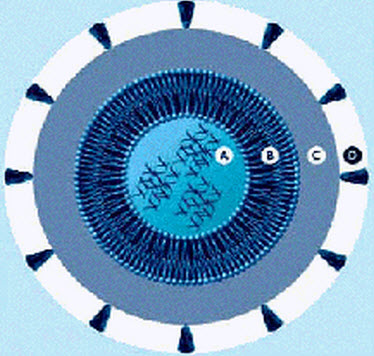Nano-sized drug transporter targets cancer-causing oncogenes more effectively
July 28, 2011

Nanoparticle design. The payload (A) is embedded within concentric layers of chemical components for delivery into cells and intracellular trafficking (B-lipid layer), protection against degradation (C-stealth/biocompatibility polymer layer) and delivery to target cells (D-biological targeting ligand layer). (Credit: K. Kostarelos & A. D. Miller, Chem. Soc. Rev., 2005, 34, 970)
Seeking to improve cancer treatments, Ohio State University scientists have created a tiny drug transporter (nanocarrier) design that maximizes its ability to silence damaging genes by more effectively penetrating a target cell.
The researchers used small interfering RNA (siRNA), an important gene-regulation mechanism that has the potential to protect cells against invaders, such as viruses, or to diminish the activity of oncogenes that cause cancer.
The siRNA were encased in the lipid-based (containing fatty-molecules) nanocarrier to silence genes, rendering the genes unable to produce proteins that lead to disease or other health problems. Specific helper molecules were attached to the carrier’s surface to enhance the transporter’s effectiveness.
In experiments in cells comparing the effects of traditional carriers and the researcher’s nanocarrier, the researchers found that siRNA delivered by the nanocarrier was about six times more effective at silencing target gene activity than the siRNA transported by traditional carriers. Their nanocarrier reduced the associated protein production by 95 percent, compared to a 70.6 percent reduction in proteins resulting from the use of the traditional carrier.
The researchers said the increased exposure of siRNA to the main part of the cell was a result of the use of helper molecules on the surface that help it slip more easily into the cell.
Their work was selected for a 2011 American Association of Pharmaceutical Scientists (AAPS) Innovation in Biotechnology Award. The researchers were invited to present the work at the recent AAPS National Biotechnology Conference.
Ref.: C. Zhou, L. J. Lee, and R. J. Lee, Cellular pharmacokinetics (PK) and target gene knockdown of surfactant- and lipid-based nanocarriers (NCs) of siRNA, 2011; [link]